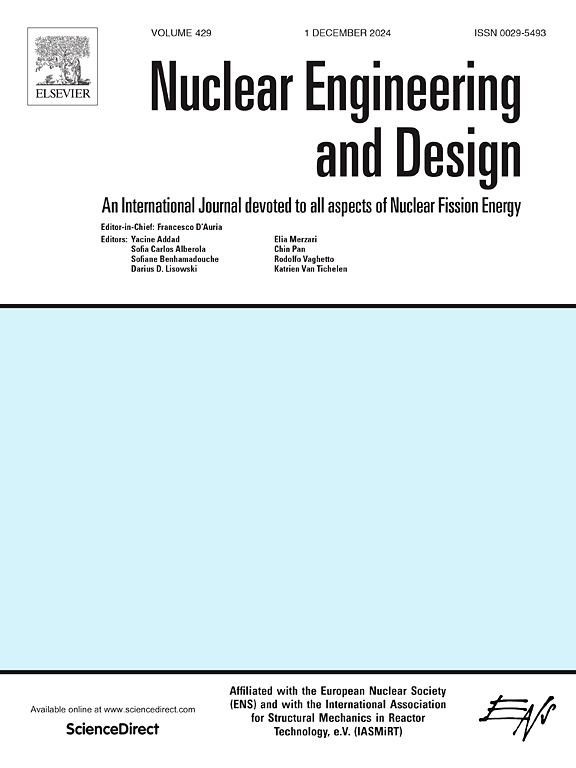Experimental study on natural circulation flow fluctuation characteristics in tube bundle channels under marine conditions
IF 1.9
3区 工程技术
Q1 NUCLEAR SCIENCE & TECHNOLOGY
引用次数: 0
Abstract
Natural circulation steam generators are of most importance for floating nuclear power plants and nuclear propulsion systems. Marine U-tube steam generators have the characteristics of natural circulation with free liquid surface, and lateral non-uniform heating, coupled with ocean motion, making the flow behavior extremely complex. Therefore, the paper built an experimental platform for natural circulation flow in tube bundle channels with the ability of non-uniform heating under marine conditions, conducting a series of experiments to study the effects of inclination, rolling motion, non-uniform heating, and the above-coupled action on flow fluctuation behavior of natural circulation. The experimental results indicate that rolling motion can cause periodic fluctuations in the natural circulation flow rate, but there are two peaks of the flow rate during one rolling period, which is caused by the periodic aggregation and discharge of bubbles. The increase in heat flux can increase the number of bubbles, making them more susceptible to rolling motion, and it can also increase the steam flow rate, resulting in a more stable flow. The fluctuation of the flow rate increases with the increase of rolling amplitude and frequency, and it is more sensitive to variations in rolling amplitude. The introduction of non-uniform heating results in a significant difference in the two peaks of flow rate during one rolling cycle, thereby exacerbating the degree of flow fluctuations under rolling motion.
海洋条件下管束通道自然循环波动特性实验研究
自然循环蒸汽发生器是浮动核电站和核动力推进系统的重要组成部分。船用u型管蒸汽发生器具有自由液面自然循环和侧向不均匀加热的特点,再加上海洋运动,使其流动行为极为复杂。因此,本文搭建了海洋条件下具有非均匀加热能力的管束通道自然循环流动实验平台,进行了一系列实验,研究了倾斜、滚动运动、非均匀加热以及上述耦合作用对自然循环流动波动行为的影响。实验结果表明,滚动运动可以引起自然循环流量的周期性波动,但在一个滚动周期内,流量存在两个峰值,这是由气泡的周期性聚集和排出引起的。热通量的增加可以增加气泡的数量,使其更容易受到滚动运动的影响,并且还可以增加蒸汽流量,从而产生更稳定的流动。流量的波动随轧制幅值和频率的增加而增大,且对轧制幅值的变化更为敏感。非均匀加热的引入使得一个轧制周期内的两个流量峰值存在显著差异,从而加剧了轧制运动下的流量波动程度。
本文章由计算机程序翻译,如有差异,请以英文原文为准。
求助全文
约1分钟内获得全文
求助全文
来源期刊

Nuclear Engineering and Design
工程技术-核科学技术
CiteScore
3.40
自引率
11.80%
发文量
377
审稿时长
5 months
期刊介绍:
Nuclear Engineering and Design covers the wide range of disciplines involved in the engineering, design, safety and construction of nuclear fission reactors. The Editors welcome papers both on applied and innovative aspects and developments in nuclear science and technology.
Fundamentals of Reactor Design include:
• Thermal-Hydraulics and Core Physics
• Safety Analysis, Risk Assessment (PSA)
• Structural and Mechanical Engineering
• Materials Science
• Fuel Behavior and Design
• Structural Plant Design
• Engineering of Reactor Components
• Experiments
Aspects beyond fundamentals of Reactor Design covered:
• Accident Mitigation Measures
• Reactor Control Systems
• Licensing Issues
• Safeguard Engineering
• Economy of Plants
• Reprocessing / Waste Disposal
• Applications of Nuclear Energy
• Maintenance
• Decommissioning
Papers on new reactor ideas and developments (Generation IV reactors) such as inherently safe modular HTRs, High Performance LWRs/HWRs and LMFBs/GFR will be considered; Actinide Burners, Accelerator Driven Systems, Energy Amplifiers and other special designs of power and research reactors and their applications are also encouraged.
 求助内容:
求助内容: 应助结果提醒方式:
应助结果提醒方式:


